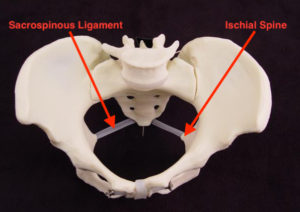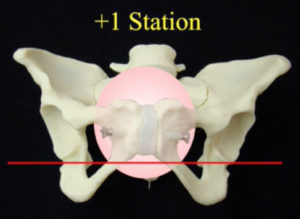Duration = 8:28
00:00
APGO educational topic number eleven
00:02
intrapartum care meet la florida live
00:05
which she is a gravida one pair zero at
00:07
39 weeks estimated gestational age and
00:10
we are going to follow her through the
00:11
process of a normal labor and delivery
00:13
the learning objectives are to
00:15
differentiate between the signs and
00:17
symptoms of true and false labor perform
00:19
the initial assessment of a laboring
00:21
patient describe the four stages of
00:23
labor and recognize common abnormalities
00:25
explain pain management approaches
00:27
during labor describe methods for
00:29
monitoring the mother and fetus describe
00:32
the steps of a vaginal delivery list
00:34
indications for operative delivery and
00:36
finally identify maternal risks specific
00:39
to delivery in developing countries
00:41
labora is at home feeling contractions
00:44
and she’s not sure if she’s in true or
00:45
false labor what is the definition of
00:47
labor let’s check our smart device the
00:50
definition of labor requires that two
00:52
things need to occur number one painful
00:55
uterine contractions and number two
00:56
cervical dilation at term many women
01:00
will feel spontaneous contractions which
01:01
they describe as tightening of the
01:03
uterus if they are not causing cervical
01:05
dilation then they are referred to as
01:06
Braxton Hicks contractions labora is on
01:09
the phone with her OB provider and she’s
01:11
trying to decide whether she should come
01:12
in to be evaluated on labor and delivery
01:14
what does the OB provider recommend come
01:17
in if you have leakage of fluid bleeding
01:19
painful contractions every five minutes
01:22
for one hour or decrease in fetal
01:24
movements laborious contractions are
01:27
every five minutes and they happen for
01:29
one hour so she and her partner head to
01:31
labor and delivery
01:31
in triage laborious prenatal records
01:34
will be reviewed and a focused history
01:36
will be performed let’s review the
01:39
assessments unique to pregnancy and
01:41
labor and delivery we need to assess
01:43
both maternal and fetal status fetal
01:46
heart tones are usually assessed with a
01:47
fetal heart monitor we also need to know
01:50
fetal presentation whether the fetuses
01:52
vertex or breech assess with either an
01:54
abdominal ultrasound or by exam since we
01:56
need to assess whether labora is in
01:58
labor we need to perform a sterile
01:59
vaginal examination we described three
02:01
components from this exam we assess the
02:03
cervical dilation the effacement and the
02:05
fetal station will first discuss
02:08
cervical dilation and effacement here is
02:11
the uterus and the cervix with the
02:13
internal
02:13
and the external loss the cervix will
02:15
dilate and this refers to the opening of
02:17
the internal loss complete dilation is
02:19
10 centimeters the cervix will also
02:22
undergo a Faceman which means that it
02:23
will thin out or the distance between
02:25
the internal and the external
02:27
awesome marked by the screen error will
02:29
become zero a non effaced cervix is
02:31
about four centimeters this green dotted
02:34
line shows a cervix that is about 50%
02:36
thinned out or will be about two
02:38
centimeters and this pink dotted line
02:41
shows a completely effaced cervix that
02:43
is zero centimeters thick moving on to
02:45
fetal station station describes the
02:48
fetal presenting part usually the vertex
02:50
in relation to the issue of spines which
02:51
are palpable vaginally when the
02:53
presenting parts at the level of the
02:54
ischial spines it is zero station as the
02:57
vertex descends down the pelvis the
02:59
station passes plus one plus two all the
03:01
way to plus five these divisions
03:02
represent centimeters below the ischial
03:04
spines on the other hand a minus one
03:07
station would meet the vertex was still
03:08
one centimeter above the ischial spine
03:10
minus 2 station would be 2 centimeters
03:12
above etc labora is found to be 5
03:15
centimeters dilated 80% effaced and 0
03:18
station so she is now admitted to labor
03:20
and delivery we described four stages of
03:22
labor the first stage of labor is from
03:25
the onset of labor to full cervical
03:27
dilation stage one is further divided
03:29
into the latent phase and the active
03:31
phase labora is already passed the
03:33
latent phase which includes from
03:34
cervical dilation to about 4 centimeters
03:37
and can be variable in length the active
03:39
phase starts at about 4 centimeters
03:41
dilated and there should be more rapid
03:43
and predictable cervical dilation the
03:45
latent phase can last for days whereas
03:47
the cervix should dilate at
03:49
approximately 1.2 to 1.5 centimeters per
03:52
hour in the active phase stage 2 is from
03:54
complete dilation to delivery of the
03:56
infant stage 3 is from delivery of the
03:59
infant to delivery of the placenta stage
04:02
4 is the immediate postpartum period of
04:04
approximately two hours after delivery
04:05
of the placenta labora is in the active
04:08
phase of stage 1 of labor walking is
04:10
generally more comfortable than laying
04:12
supplying there is decreased GI
04:14
peristalsis so patients should limit
04:15
their solid food intake for this can
04:17
lead to nausea and vomiting fetal
04:20
well-being is monitored during labor by
04:22
measurement of the fetal heart tones
04:23
which can be done by either electronic
04:25
fetal monitoring or intermittent oskol
04:27
an external toka motor is used to assess
04:29
uterine activity labor would like for us
04:32
to start discussing pain management
04:33
options during labor labor results
04:35
severe pain for most women during stage
04:38
1 of labor pain results from the
04:40
contractions of the uterus and dilation
04:42
of the cervix resulting in visceral pain
04:44
at the levels of T 10 to l1 as labor
04:47
progresses the fetal head distance the
04:49
lower birth canal and perineum resulting
04:51
in somatic pain transmitted through s2
04:53
to s4 some patients tolerate the pain of
04:56
labor and delivery without any need for
04:58
medications for women who opt for pain
05:00
relief during labor we have many safe
05:02
effective methods the epidural block is
05:04
the most effective form of intrapartum
05:06
pain relief in the United States local
05:08
anesthetic or narcotics are infused
05:10
through a catheter into the epidural
05:12
space this lasts during labor and
05:14
delivery and can be individually
05:15
titrated IV opioids and opioid agonist
05:19
and antagonist can also be used however
05:21
since they are systemically administered
05:23
the primary mechanism of pain relief is
05:25
via a sedation labora is now completely
05:28
dilated at 10 centimeters and is now in
05:30
stage 2 of Labor
05:31
how long do women push once they are
05:34
completely dilated for women who have
05:36
not had a vaginal delivery pushing
05:38
usually takes about two to three hours
05:39
the length is shorter if the woman has
05:41
not received an epidural if a woman has
05:44
already had one vaginal delivery the
05:46
second stage may be very short and she
05:48
may not need to push for very long since
05:51
this is laborious first delivery she
05:52
will likely need to push for 2 to 3
05:54
hours as a student you may stay in the
05:56
room to help with this pushing part of
05:58
stage 2 delivery of the fetus is
06:00
imminent when a half dollar size amount
06:02
of the fetal vertex is visible in
06:04
between pushes as the fetus crowns it is
06:07
helpful to support the perineum and
06:09
facilitate extension of the head after
06:11
delivery of the head there is
06:13
restitution then there is delivery of
06:16
the anterior shoulder then the delivery
06:19
of the posterior shoulder the optimum
06:21
place for baby after delivery is skin to
06:23
skin on the maternal chest next we’ll
06:25
move on to stage 3 active management of
06:28
the third stage of labor it decreases
06:30
the risk of postpartum hemorrhage this
06:32
involves bundle massage gentle core
06:34
traction and administration of IV or I
06:36
am oxytocin the placenta can take up to
06:39
30 minutes to do
06:41
there are two classic signs that the
06:42
placenta is separating from the uterus
06:44
one a gush of blood and two lengthening
06:47
of the umbilical cord after the placenta
06:50
delivers the uterus should be palpated
06:51
to ensure that it is firm and has
06:53
contracted and the placenta should be
06:55
visually examined to make sure it has
06:57
been completely removed moving now to
06:59
operative deliveries operative
07:01
deliveries are accomplished by applying
07:03
direct traction to the fetal skull with
07:05
forceps or by applying traction to the
07:07
fetal scalp with a vacuum extractor the
07:10
incidence of operative vaginal delivery
07:12
in the United States is estimated to be
07:13
approximately 3.5% the general
07:16
indications are one prolonged or
07:18
arrested second stage number two
07:20
suspicion of immediate or potential
07:22
fetal compromise and number three
07:24
shortening of the second stage for
07:26
maternal benefit our journey on to labor
07:28
and delivery with our patient labora has
07:30
assumed that we are in a high resource
07:32
setting in low resource settings there
07:34
are a multitude of risks of labor and
07:36
delivery and 99% of maternal deaths
07:38
occur in developing countries every day
07:41
800 women die from preventable causes
07:43
related to pregnancy and childbirth this
07:45
is the equivalent of two jumbo jets
07:47
daily more than half of these deaths
07:49
occur in sub-saharan Africa and another
07:51
one-third occur in Southeast Asia the
07:54
highest risk is for adolescent girls the
07:56
major complications that account for 75%
07:58
of maternal deaths are bleeding
08:00
infection high blood pressure
08:02
complications from delivery and unsafe
08:04
abortion this concludes the aapko video
08:06
on intrapartum care we reviewed normal
08:08
labor and delivery operative deliveries
08:10
and maternal risks specific to
08:12
developing countries
08:19
[Music]
I believe the video is a little unclear about the exact location of the ischial spines. Here are a couple of images that I hope will clarify their location and clinical use.
– Dr. Hughey


Definitions of the latent and active phases of the first stage of labor have changed over time.
This came about after a workshop was convened with ACOG, Society of Maternal Fetal Medicine (SMFM) and the NIH to address the high Cesarean delivery rates in the U.S. resulting in the publication of “Safe Prevention of the Primary Cesarean Delivery.”
Data suggest that the active phase of labor more likely begins at approximately 6 cm dilation (previously 4 cm). Data also suggest that the active phase of labor and the 2nd stage of labor (pushing) can take longer than previously believed. Generally, we wait 4-6 hrs in the active phase of labor before diagnosing arrest of dilation and can wait up to 4 hr in the second stage of labor before diagnosing arrest of descent. Each of these changes should give patients more time to deliver vaginally without compromising safety.
– Dr. Smith
